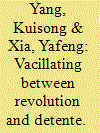| Srl | Item |
| 1 |
ID:
112744


|
|
|
|
|
| Publication |
2012.
|
| Summary/Abstract |
This article surveys some of the challenges that President Obama or his successor
will face over the next several years as the United States attempts to "pivot
toward Asia." In view of the ongoing shift in power from West to East, Washington
can no longer assume that it can preserve or transform Asia-Pacific security by its
unilateral actions. Rather, the United States must develop a "lead from behind"
strategy that will assist America's Asia-Pacific friends and allies to "make room
for China" while at the same time encouraging them to take greater responsibility
for regional security. As it develops its plans for the Asia-Pacific region, the
United States will have to accord special attention to three legacy issues (the
China-Taiwan relationship, the unresolved confrontation between North and
South Korea, and the incompatibility of American and Chinese values) which
have confounded U.S.-China relations for six decades. If managed properly, a
U.S. pivot toward Asia can be beneficial to both the United States and America's
regional friends and allies. But this will require Washington to pursue what President
Obama recently described as a "more centered course" that leverages America's
assets in the Asia-Pacific while avoiding policies that force regional governments
to choose between Washington and Beijing.
|
|
|
|
|
|
|
|
|
|
|
|
|
|
|
|
| 2 |
ID:
095533


|
|
|
|
|
| Publication |
2010.
|
| Summary/Abstract |
After nearly twenty-two years of confrontation and hostility between the United States and the People's Republic of China (PRC), U.S. president Richard Nixon made his historic trip to China and met with Chinese supreme leader Mao Zedong in February 1972. Nixon's one week in China represented a profound turning point in U.S.-China relations. The historic Nixon-Mao handshake stood as a great diplomatic victory for Beijing as well. The Chinese leaders could now focus their attention on the Soviet threat and avoid fighting a possible two-front war. A Chinese Communist party (CCP) Central Committee (CC) document hailed the summit for its success in "utilizing [others'] contradictions, dividing up enemies, and enhancing ourselves," and credited this to Mao's "brilliant decision" to invite the U.S. president.1 Nixon and Mao have often been given credit for achieving U.S.-China rapprochement in the early 1970s. Was Mao really a realistic leader as many have suggested?
|
|
|
|
|
|
|
|
|
|
|
|
|
|
|
|